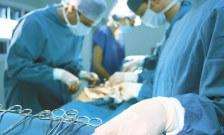World's first soft-robotic surgery on a human body

A team of roboticists, engineers and surgeons at King's College London have for the first time operated on a human body using a soft surgical robot as part of keyhole surgery, with the aim of dramatically improving future surgical practice. Under the guidance of expert surgeons, the team used the robot to operate on human cadavers as well as medical manikins.
Once inserted into the body through a small incision in the abdomen, known as a Trocar port, the new robot provides surgeons with unparalleled video feedback from inside the body, making it ideal for abdominal surgery.
Taking inspiration from soft-bodied animals, the team from the E.U.-funded Stiffness controllable Flexible and Learnable manipulator for surgical operations (STIFF-FLOP) project have already made new ground creating robotic devices specifically for minimally invasive surgery (MIS), opening up areas previously inaccessible to surgeons using current keyhole surgery techniques.
Surgeons today rely on conventional surgical robots based on structures made from rigid components which only move in straight lines, consequently giving access to a limited number of sites.
Made from two segments of silicone material, the new surgical robot is equipped with three air chambers per segment allowing elongation and bending in all directions. It thus mimics an octopus' ability to move its tentacles, enabling the robot to squeeze through narrow openings and past delicate organs without damaging them.
The improved dexterity and flexibility of the new robot and superior visual feedback allows surgeons to investigate and explore many more of the narrow tunnel-like structures within the body. The robot can also be fitted with surgical tools such as grippers or cutters to make it a fully functional surgical tool.
Professor Kaspar Althoefer, Professor of Robotics and Intelligent Systems at King's and the lead researcher said: 'We wanted to recreate the fascinating abilities of some animals such as the octopus which can instantaneously morph their tentacles from soft to stiff and back again, to give surgeons a safe way to navigate the human body, overcoming the difficulties they currently have with traditional tools and instruments. The results from our work with STIFF-FLOP show that this new robot is the answer and we look forward to taking soft robotics beyond surgical robotics into other areas such as repairing underwater pipelines or search and rescue operations.'
Professor Prokar Dasgupta, Chair of Robotic Surgery and Urological Innovation, MRC Centre for Transplantation, KCL and Chairman, King's-Vattikuti Institute of Robotic Surgery said: 'Soft robots have a great future in surgery and beyond. The STIFF-FLOP system allows greater flexibility, incorporation of images and returns the sense of touch (haptics) to the surgeon. It also learns from the surgeons' movements to avoid dangerous structures nearby such as blood vessels, thus potentially making robotic surgery safer for patients.'




















